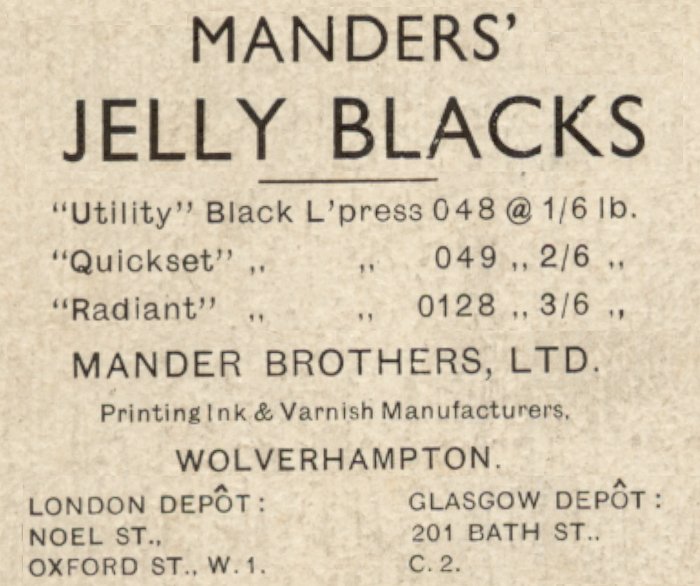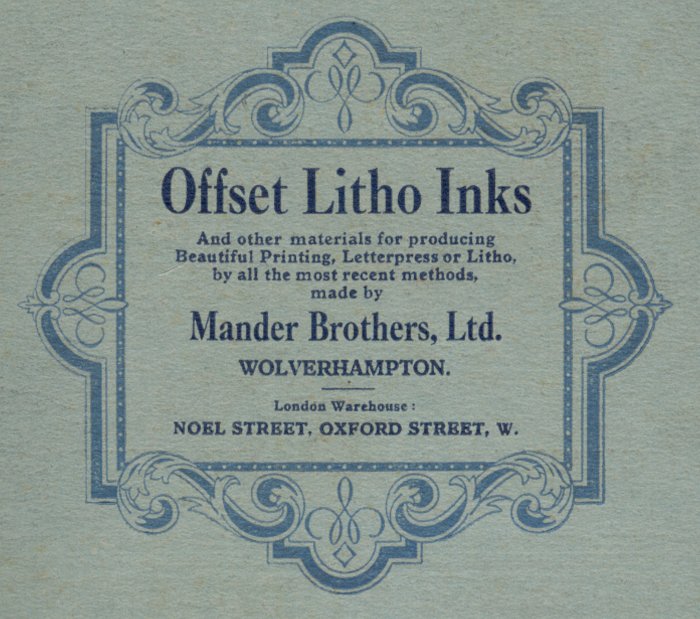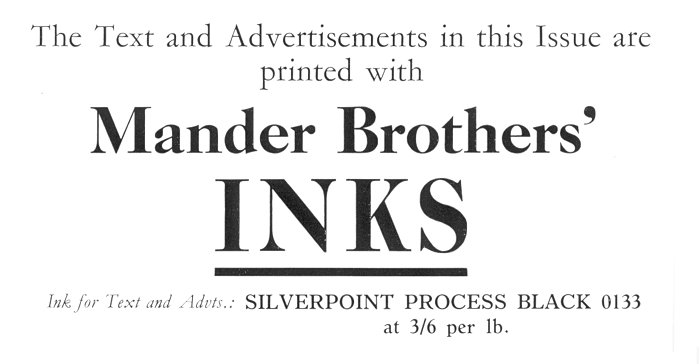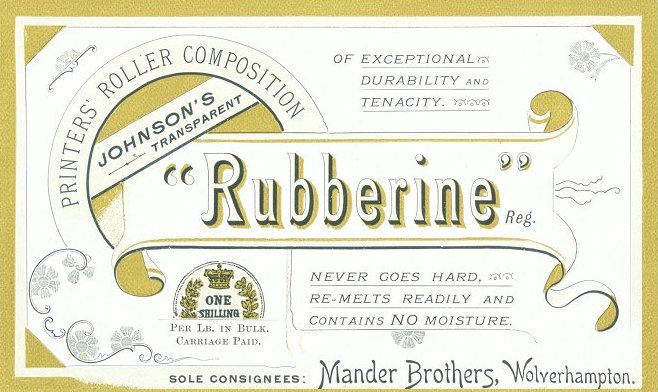The basis of all printing inks is colour (in which term is included
black) and varnish, the latter serving as the vehicle or carrier of the
former. Lamp-black is made by burning creosote or other oil in a chamber
to which a quantity of air is admitted, insufficient for complete
combustion. The result is the production of soot, just as an oil lamp
produces smoke or soot when the supply of oil is too great, or the
supply of air is too small. This soot or lamp-black is deposited in
large chambers, from which it is collected. This class of lamp-black is
used for news and the commoner kinds of inks. For the better sort, a
black which is a product of the natural gas of America and elsewhere is
preferred on account of its greater density of colour.
Dry ColoursThe exquisite and brilliant colours known as anilines,
ranging over the entire prismatic spectrum, crimsons, reds, oranges,
yellows, greens, blues and violets, and including other colours such as
browns and purples, are to a certain extent denied to the inkmaker,
because many of them are fugitive, and therefore unworthy of use in "the
art preservative of art." The ink maker uses, for his finest inks, only
such coal-tar colours as are permanent, and he therefore relies for some
of his best results on colours which are not of this series. He betakes
himself to what we may describe as mineral colours, which include
vermilion, the chromes, bronze, prussian and ultramarine blues, or the
siennas and umbers, the two last belonging to, the group known as earth
colours, owing to the fact that they are obtained as earths and are not
manufactured. All dry colours are produced in the form of lumps or
powders, which require to be broken down or ground down before
incorporation with the varnishes.

Varnishes
Many different varnishes are used by ink makers, but
the principal ones are those prepared from resin and linseed oils
respectively. The former is used for news and the commoner kinds of
inks, the latter for the better sorts. The best oil is genuine, well
matured, unadulterated, Russian Baltic linseed oil, costing a
high price, and the worst are the rough, ill-matured Calcutta
brands, which cost very much less, and which may be adulterated
to any extent. An ill-matured oil is easily discovered when it
is put into a varnish pot and heated, for it froths up and there
are deposited what are technically known as " foots." The
function of all varnishes is two-fold:
1. To act
as a vehicle or carrier of the colour.
2. To act as a drying agent.
Without the vehicle it would be impossible to
get the colour conveyed to the formes and blocks, and without
this drying agent, the printed matter would never be got into
the customers' hands in the marvellously short time in which
this is effected. Linseed oil, when subjected to prolonged
boiling at a high temperature, is converted into a varnish which
has an extraordinary affinity for oxygen.
Ink Prepared from Linseed Varnish
Varnish greedily, absorbs oxygen from the air, and this converts it from
a gummy substance into a compound which is solid at the ordinary
temperature of the air, the ink, in fact, is dry! This drying operation
is also assisted by the absorbent action of the printing paper and by
other means known to certain ink makers. Thick varnish, having absorbed
more oxygen during the boiling process, makes an ink having less drying
power than one made from thin varnish, but a thick varnish carries more
colour.
Varnishes for special purposes, such as the manufacture of bronze blue
ink, are "flared," which process consists in first heating the varnish
and then setting it on fire, thereby removing all greasy matter.
The colour is ground into the varnish in various proportions and for
various lengths of time, but always so that the finest subdivision of
the colour is obtained. With skilled workmen and ordinary care it is
next to impossible to make a badly ground ink with the latest ink
mills.

Letterpress Inks
Under this heading are included inks used upon
such dissimilar machines as modern high-speed rotaries and toy
platens, and for such different purposes as printing newspapers
or three colour illustrations. Whatever the machine, however,
and to whatever use that machine is put, the ink supply must
meet the following requirements:
|
1. |
It must
distribute freely, and be of the
right consistency and "tackiness." |
|
2. |
It must dry with
that degree of rapidity which the
speed of the particular machine and the
exigencies of the customer demand; and while it dries
with rapidity on the paper, it must not do so on the
rollers and slab. |
|
3. |
The ink must work cleanly, and
neither fill up the forme, nor cause set off. |
|
4. |
It must be of the greatest
density of colour if a black ink, and also of the exact right shade
if a coloured one. |
|
5. |
It must contain
the maximum weight of colour ground into the minimum weight of varnish,
compatible with the consistency required. |
Lithographic Inks
Lithographic inks are much stiffer than letterpress, and are
made from specially prepared varnishes; they require more power
to grind and contain more colour, and therefore usually cost
rather more. A lithographic ink cannot be too well ground for
the average high quality of work which is done with it on the
delicate surface of the stone. It is very important that
lithographic inks should be unaffected by the water used in this
process, and also that they should be non-acid, otherwise the
work on the stone becomes " eaten off." This last-named result
is sometimes caused, however, by badly ground inks.

The Mixing of Inks by the Printer
Unless the chemical composition of the dry colours
used is known more or less, it is very hard to say what inks will mix,
and the ink maker should be consulted. If a printer uses inks from one
maker only, it is an easy matter for that firm to tell him which inks
would, and which would not mix, since they would know what colours had
been used in the inks. But it would be necessary for anyone else to make
an analysis of the inks before being able to say definitely whether or
not they would be affected by each other. Supposing a printer was to mix
cadmium yellow with, say, flake white, he might be surprised to find the
resulting colour blacken. This, however, is what might be expected when
one remembers that cadmium yellow is the sulphide of cadmium and flake
white is lead carbonate, and that the lead sulphide resulting from the
mixture is black. Far and away the most common chemical action to be
feared by careless mixing, is mixing a lead colour with one containing
sulphur.
Some inks do not work evenly, and
this is specially noticeable in solid blocks, a mottled
appearance being produced. The degree of mottle depends a great
deal on the printer, some being able to get over the difficulty
better than others. Bronze blues, ultramarine blues and
inks made from earth colours seem the chief offenders. The cause
is to be found in the physical properties of the dry colours,
some seeming to have less affinity for the varnish and not
making so perfect a mechanical mixture.
The earth colours, being particularly hard and
difficult to grind, do not mix so readily with the varnish. The remedy,
given that the printer has failed, is to let the ink maker know all the
conditions under which the fault arose and to allow him to amend the ink
to suit the particular work. Variation of covering power in given
weights of ink occurs at times, and the cause lies again in the physical
properties of the dry colour, which cannot always be explained. Nothing
in the way of an alkali should be added to an ink, as many colours would
be decomposed. Bronze blue, for instance, would be decomposed to iron
oxide (rust). In the same way nothing having acid properties should be
added, as an equally bad result might be produced.
Whatever the ink, a thorough knowledge of the
nature and speed of the printing machine, the
kind of work to be done and the paper to be used
is essential before the ink- maker can supply a
satisfactory ink. It is an advantage if the ink
seller possesses a thorough knowledge of papers
and papermaking as he is then able to judge and
even to advise as to what ink will best suit a
given paper.

|